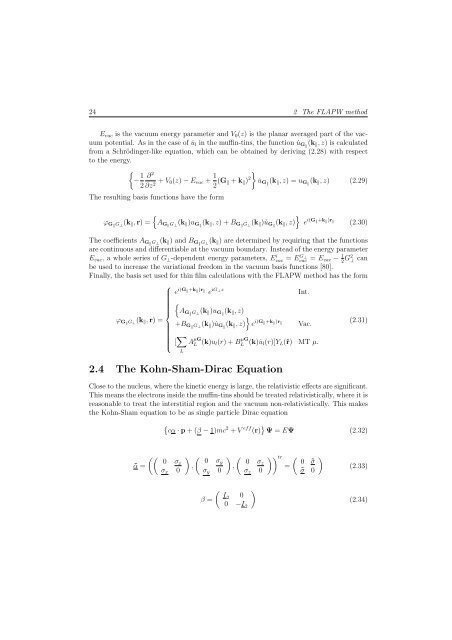Ab initio investigations of magnetic properties of ultrathin transition ...
Ab initio investigations of magnetic properties of ultrathin transition ...
Ab initio investigations of magnetic properties of ultrathin transition ...
You also want an ePaper? Increase the reach of your titles
YUMPU automatically turns print PDFs into web optimized ePapers that Google loves.
24 2 The FLAPW method<br />
Evac is the vacuum energy parameter and V0(z) is the planar averaged part <strong>of</strong> the vacuum<br />
potential. As in the case <strong>of</strong> ˙ul in the muffin-tins, the function ˙uG � (k�,z) is calculated<br />
from a Schrödinger-like equation, which can be obtained by deriving (2.28) with respect<br />
to the energy.<br />
�<br />
− 1 ∂<br />
2<br />
2<br />
∂z2 + V0(z) − Evac + 1<br />
2 (G� + k�) 2<br />
�<br />
The resulting basis functions have the form<br />
ϕG�G⊥ (k�,<br />
�<br />
r) =<br />
AG �G⊥ (k�)uG � (k�,z)+BG �G⊥ (k�)˙uG � (k�,z)<br />
˙uG � (k�,z)=uG � (k�,z) (2.29)<br />
�<br />
e i(G �+k �)r � (2.30)<br />
The coefficients AG �G⊥ (k�) and BG �G⊥ (k�) are determined by requiring that the functions<br />
are continuous and differentiable at the vacuum boundary. Instead <strong>of</strong> the energy parameter<br />
Evac, a whole series <strong>of</strong> G⊥-dependent energy parameters, E i vac = E G⊥<br />
vac = Evac − 1<br />
2 G2 ⊥ can<br />
be used to increase the variational freedom in the vacuum basis functions [80].<br />
Finally, the basis set used for thin film calculations with the FLAPW method has the form<br />
ϕG�G⊥ (k�,<br />
⎧<br />
e<br />
⎪⎨<br />
r) =<br />
i(G�+k�)r� iG⊥z<br />
e<br />
�<br />
AG�G⊥ Int.<br />
(k�)uG (k�,z)<br />
� �<br />
(2.31)<br />
+BG �G⊥ (k�)˙uG � (k�,z)<br />
⎪⎩ [ �<br />
L<br />
e i(G �+k �)r � Vac.<br />
A μG<br />
μG<br />
L (k)ul(r)+BL (k)˙ul(r)]YL(ˆr) MT μ.<br />
2.4 The Kohn-Sham-Dirac Equation<br />
Close to the nucleus, where the kinetic energy is large, the relativistic effects are significant.<br />
This means the electrons inside the muffin-tins should be treated relativistically, where it is<br />
reasonable to treat the interstitial region and the vacuum non-relativistically. This makes<br />
the Kohn-Sham equation to be as single particle Dirac equation<br />
� � 2 eff<br />
cα · p +(β − 1)mc + V (r) Ψ = EΨ (2.32)<br />
˜α =<br />
�� 0 σx<br />
σx 0<br />
� �<br />
0 σy<br />
,<br />
σy 0<br />
� �<br />
0 σz<br />
,<br />
σz 0<br />
� �<br />
I2 0<br />
β =<br />
0 −I2 ��tr<br />
=<br />
�<br />
0<br />
�<br />
˜σ<br />
˜σ 0<br />
(2.33)<br />
(2.34)

















